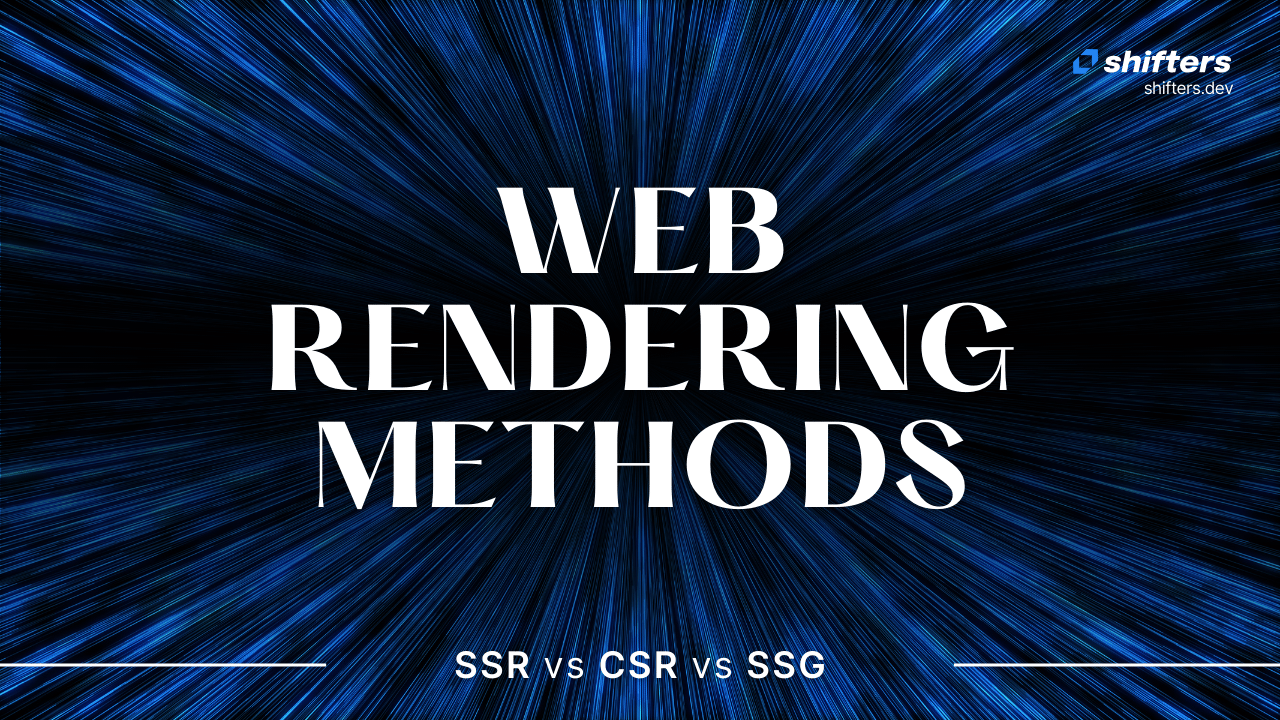Building a website today means making important decisions about how your pages will load for visitors. The way your content gets delivered to users affects everything from loading speed to search rankings to user experience. This choice can make or break how people interact with your site.
There are three main approaches to handle web rendering: Server-Side Rendering (SSR), Client-Side Rendering (CSR), and Static Site Generation (SSG). Each method has its own benefits and drawbacks, and understanding these differences helps you pick the best option for your specific needs.
What is web rendering?
Web rendering is the process of turning your code and data into the visual webpage that users see and interact with. Think of it like preparing a meal - you can cook it in the kitchen and serve it ready to eat, bring ingredients to the table and cook there, or prepare meals ahead of time and just reheat when needed.
The main question is: where should this "preparation" happen? You can do it on your server, in the user's browser, or ahead of time during development. Each approach affects loading speed, user experience, and how search engines see your content. As web technology keeps advancing, developers have more options than ever to create fast, engaging websites.
Server-side rendering (SSR)
Server-Side Rendering means your server creates complete HTML pages before sending them to users. When someone visits your website, the server processes all the necessary HTML, CSS, and JavaScript, then sends a fully formed page ready for display.
This approach puts most of the work on your server rather than the user's device. The browser receives a complete page that can display immediately, without waiting for additional scripts to load and build the content. It's like having a chef prepare your entire meal in the kitchen before bringing it to your table.
Benefits of SSR
Fast initial loading: Users see content almost immediately because the server delivers a complete, ready-to-display page. This quick loading time improves user experience significantly, especially for first-time visitors who haven't cached any resources yet.
Better search engine results: Google and other search engines can easily crawl and index your content since everything is present in the HTML from the start. This leads to better visibility in search results and higher rankings, which is crucial for getting organic traffic.
Works well on slow connections: Since the server handles most processing, users with slower internet or older devices still get a good experience. The heavy lifting happens on your powerful server instead of their potentially limited device.
Enhanced security: Sensitive data processing stays on the server, protected from client-side exposure. This is particularly important for applications handling user data, payments, or other confidential information.
Challenges with SSR
Higher server demands: Your server works harder to render content for every request, especially with high traffic or complex applications. This often means needing more robust infrastructure, which increases hosting costs and complexity.
Limited smooth interactions: Since pages are pre-rendered server-side, dynamic interactions requiring new data often need full page reloads. This creates a less fluid experience compared to modern single-page applications.
Complex development setup: Implementing SSR requires careful server configuration and data handling strategies. Developers must manage dependencies and ensure that server-rendered content delivers correctly without errors.
Server-Side Rendering (SSR) Example (Next.js):
export async function getServerSideProps() {
const res = await fetch('https://api.example.com/data');
const data = await res.json();
return { props: { data } };
}
export default function Home({ data }) {
return (
<div>
<h1>Server-Side Rendering with Next.js</h1>
<p>Data fetched from the server: {data.message}</p>
</div>
);
}This code fetches data on every request on the server and sends fully rendered HTML to the client.
Client-side rendering (CSR)
Client-Side Rendering shifts the page-building process to the user's browser. Instead of receiving complete pages, users get a basic HTML shell along with JavaScript files that build the actual content dynamically.
When someone visits a CSR-powered site, their browser downloads the necessary JavaScript, then uses it to fetch data and create the webpage. This allows for highly interactive experiences since the page can update content without reloading, creating smooth, app-like functionality.
Benefits of CSR
Smooth page transitions: Once loaded, moving between different sections feels instant since JavaScript updates content without full page reloads. This creates an experience similar to native mobile apps, keeping users engaged.
Real-time functionality: Applications can update content immediately as new data becomes available. Chat applications, live dashboards, and collaborative tools benefit greatly from this immediate responsiveness.
Reduced server load: By moving rendering work to user devices, your server mainly handles data requests through APIs. This allows servers to support more concurrent users without expensive infrastructure upgrades.
Flexible development: Developers can create complex user interfaces more easily since everything happens in the browser. This enables rich interactions and dynamic features that would be difficult with traditional server-rendered approaches.
Challenges with CSR
Slower initial loading: First-time visitors must download JavaScript frameworks and application code before seeing useful content. This delay can frustrate users, especially those on mobile devices or slower connections, potentially increasing bounce rates.
Search engine difficulties: While search engines have improved at processing JavaScript, they still prefer static HTML content. Dynamic content that loads after the initial page request may not get indexed properly, hurting search rankings.
Accessibility concerns: Screen readers and assistive technologies may struggle with content that appears after page load. Developers need extra care to ensure dynamic content updates are announced properly to users with disabilities.
Client-Side Rendering (CSR) Example (React):
import { useEffect, useState } from 'react';
function App() {
const [data, setData] = useState(null);
useEffect(() => {
fetch('https://api.example.com/data')
.then(res => res.json())
.then(setData);
}, []);
return <div>{data ? data.message : 'Loading...'}</div>;
}
export default App;Here, the initial HTML is minimal, and data is fetched and rendered dynamically in the browser after page load.
Static site generation (SSG)
Static Site Generation takes a completely different approach by pre-building all pages during development rather than when users request them. The build process creates complete HTML files ahead of time, and the server simply delivers these pre-made files when needed.
This method involves setting up a build system that compiles templates, content, and scripts into a fully formed website before deployment. When content changes, you rebuild the entire site and redeploy the static files. The server's only job is serving already-complete files, making delivery extremely fast.
Benefits of SSG
Lightning-fast loading: Pages load almost instantly since they're pre-built and require no processing when requested. This speed significantly improves user engagement and reduces bounce rates, as users strongly prefer fast-loading sites.
Cost-effective hosting: Serving static files requires minimal server resources, enabling the use of simple, inexpensive hosting solutions. You can even use content delivery networks for global distribution without complex server infrastructure.
Excellent SEO performance: Like SSR, SSG provides complete HTML for search engines to crawl and index easily. Pre-rendered content ensures maximum search visibility and ranking potential.
Strong security: With no database connections or server-side processing at runtime, there are fewer security vulnerabilities. The static nature makes sites highly resistant to common web attacks.
Limitations of SSG
Limited dynamic features: Sites requiring user-specific content, real-time updates, or frequent changes become challenging to implement. Every content update requires a complete rebuild and redeployment.
Complex build processes: Integrating dynamic data sources or APIs into the build process can become complicated. Large sites with extensive content may require sophisticated build tools and workflows.
Longer build times: As content volume grows, build times extend proportionally. Sites with thousands of pages might take significant time to rebuild, slowing down content update cycles.
Static Site Generation (SSG) Example (Next.js):
export async function getStaticProps() {
const res = await fetch('https://api.example.com/data');
const data = await res.json();
return { props: { data } };
}
export default function Home({ data }) {
return (
<div>
<h1>Static Site Generation with Next.js</h1>
<p>Data fetched at build time: {data.message}</p>
</div>
);
}This example fetches data at build time and generates static HTML files served to all users, ideal for content that rarely changes.
Making the right decision
Choosing between SSR, CSR, and SSG requires careful consideration of your specific requirements, audience, and goals. The decision impacts not just technical implementation but also user experience, maintenance complexity, and long-term scalability.
Consider these key factors when making your choice:
Content update frequency: If your content changes daily or requires real-time updates, CSR might be best. For occasionally updated content, SSG works well. For personalized content, consider SSR.
User interaction needs: Highly interactive applications often benefit from CSR's smooth experience. Simple content sites work great with SSG. Applications needing both interactivity and SEO might need SSR.
Search engine importance: If organic search traffic is crucial for your business, SSR or SSG typically perform better than CSR. E-commerce sites and content platforms particularly need strong SEO.
Technical resources: CSR requires strong front-end development skills. SSR needs server management expertise. SSG offers simplicity but may need complex build processes for dynamic data.
Performance requirements: For maximum speed, SSG usually wins. For interactive responsiveness, CSR excels. SSR provides a balanced approach with good initial loading and reasonable interactivity.
Budget considerations: SSG often costs least to host. CSR reduces server costs but may require more development time. SSR typically needs more expensive hosting but can provide better user experience.
Many modern websites successfully combine different approaches for different sections. You might use SSG for marketing pages, SSR for user dashboards, and CSR for interactive features. This hybrid approach lets you optimize each section for its specific needs.
Conclusion
Picking the right rendering method comes down to knowing what your site needs and who will use it. Don't just follow what's popular - think about what actually works for your situation. If your content doesn't change much and you want fast loading, go with SSG. If you need lots of interaction and real-time features, CSR is probably better. If you want good search results and personalized content, SSR makes sense. You can always start simple and add complexity later as your site grows. The most important thing is making your users happy with a site that loads fast and works well. Remember, the best choice is the one that fits your needs, your budget, and your team's skills. Keep it simple when you can, and your visitors will thank you for it.



